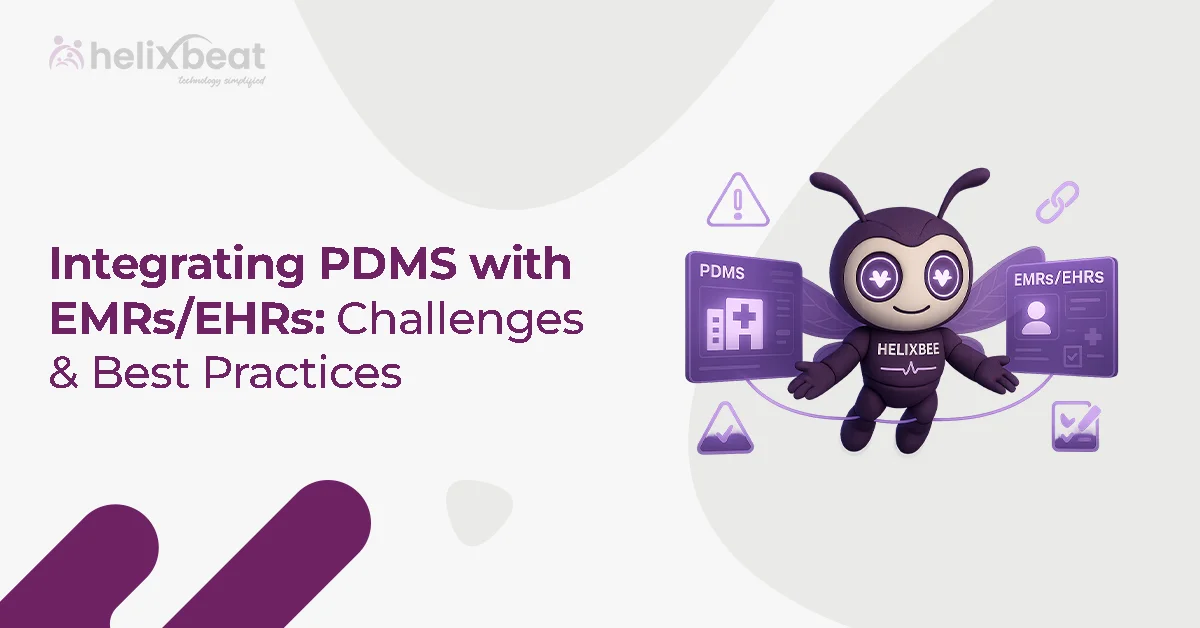Healthcare software plays a crucial role in bridging the gap between medical professionals and patients, improving care delivery and accessibility worldwide. Healthcare IT systems has advanced and becomes more complex, as a result the development of reliable software solutions becomes more challenging than before.
As healthcare systems are now expected to handle sensitive data, critical tasks, and smooth integrations, testing healthcare applications becomes becomes mandatory in every area of medicine.
At Helixbeat, our specialized healthcare testing services focus on delivering rigorous quality assurance tailored for custom medical software. Let’s explore how to test healthcare software.

Table of Contents
Short Note of Healthcare Software Testing
Healthcare software testing is the process of thoroughly evaluating healthcare applications to verify that they function correctly and securely and comply with industry regulations. It covers a wide range of software types, including electronic health records (EHR), telemedicine platforms, medical devices, and patient management systems.
This testing ensures that software is reliable, protects sensitive patient data, and supports clinical workflows without errors. Given the critical nature of healthcare, software testing in this domain requires specialized approaches to meet strict standards for safety, privacy, and interoperability.
Importance of Healthcare Testing
1. Protecting Patient Safety
Healthcare software directly impacts patient care, so even minor bugs can lead to serious consequences like misdiagnosis or treatment errors. Rigorous testing helps catch and fix issues before the software reaches real users, safeguarding patient health.
2. Complying with Regulations
Healthcare applications must follow strict regulations such as HIPAA, FDA guidelines, and GDPR. Testing verifies that software meets these legal requirements, avoiding costly penalties and maintaining trust with users.
3. Securing Sensitive Data
Medical records contain highly confidential information. Healthcare testing includes security assessments to prevent data breaches, unauthorized access, and cyber threats, protecting both patients and healthcare providers.
4. Ensuring System Reliability
Healthcare systems often operate under high pressure and heavy loads. Testing guarantees that applications perform consistently and remain stable during peak usage, minimising downtime and supporting smooth clinical operations.
Different Testing Types in Healthcare Testing
1. Functional Testing
This verifies that all features and functions of the healthcare software work as intended. It includes testing clinical workflows, patient data entry, appointment scheduling, billing processes, and other core functionalities.
2. Performance Testing
Performance testing assesses how the software behaves under different load conditions. It checks response times, scalability, and stability during peak usage to ensure the system remains reliable and efficient.
3. Security Testing
Security testing focuses on identifying vulnerabilities and risks in the software. It includes penetration testing, data encryption verification, access control checks, and compliance with data protection regulations.
4. Interoperability Testing
Healthcare systems must exchange data seamlessly with other applications and devices. Interoperability testing ensures seamless data integration, accurate communication, and compatibility with standards such as HL7 and FHIR.
5. Usability Testing
This testing evaluates the user experience for healthcare professionals and patients. It ensures that the software interface is both intuitive and accessible, thereby reducing the likelihood of human error during use.
6. Compliance Testing
Compliance testing ensures that the software meets industry-specific laws and standards, such as HIPAA for privacy, FDA regulations for medical devices, and other regional healthcare guidelines.
Health Care Application Testing Workflow
Healthcare software includes multiple modules managing members, providers, claims, finance, and compliance. Each module must be thoroughly tested to ensure accuracy, security, and smooth integration across the system. Below is a breakdown of key testing areas and their focus points.
Testing of Provider System
| Area | Details |
| Core Functions | Create, modify, and delete provider records; manage provider categories |
| Additional Features | Authenticate providers; display linked members; show broker and commission details |
| Integration Verification | Confirm seamless data flow with claims, finance, and broker systems |
Testing of Member System
| Area | Details |
| Core Functions | Register and deregister members; add or remove dependents; review and verify member information |
| Additional Features | Generate premium receipts; access payment history; process premium payments; re-enroll members |
| Integration Verification | Ensure member data updates synchronize correctly with claims, finance, and broker modules |
Testing of Broker System
| Area | Details |
| Core Functions | Add, update, and remove broker profiles; compute commissions based on premiums |
| Additional Features | Save and retrieve broker data; list members associated with brokers |
| Integration Verification | Verify broker data is accurately reflected across finance, provider, and member systems |
Testing of Claims System
| Area | Details |
| Core Functions | Check claim statuses; add or update claims for members and dependents; validate claim details |
| Additional Features | Support multiple document uploads; send notifications to members; update claim statuses based on finance inputs; reject invalid claims |
| Integration Verification | Validate claim data transfers to provider and finance portals |
Testing for Regulatory Compliance
| Area | Details |
| Security Measures | Apply standard authentication protocols; restrict data access to authorized personnel; encrypt stored data; comply with regional regulations |
| Data Access Controls | Implement least privilege principles to minimize access |
| Secure Data Transfer | Ensure all data transmissions are encrypted |
| Audit Requirements | Maintain detailed logs of all transactions and system records |
Testing of Finance System
| Area | Details |
| Core Functions | Execute payments; retrieve payment statuses; verify payment and account information |
| Additional Features | Allow payment retries in case of failures; notify users of payment issues |
| Integration Verification | Facilitate two-way communication with claims, provider, and broker systems |
Benefits of Healthcare Software Testing
- Enhances Patient Safety: Identifies and fixes issues before deployment, reducing risks of errors affecting patient care.
- Ensures Regulatory Compliance: Helps meet healthcare laws and standards, avoiding legal penalties and maintaining trust.
- Improves Data Security: Detects vulnerabilities to protect sensitive patient information from breaches.
- Increase System Reliability: Guarantees consistent performance and smooth operation under various conditions.
Challenges in Healthcare Testing
Testing healthcare software comes with unique challenges that impact safety, compliance, and reliability. Here are the key obstacles in healthcare testing:
- Complex Regulatory Requirements: Navigating strict standards like HIPAA, FDA, and GDPR adds layers of compliance complexity.
- Data Privacy and Security: Protecting sensitive patient data demands robust encryption and access controls during testing.
- System Interoperability: Ensuring seamless data exchange between diverse healthcare systems and third-party integrations can be difficult.
- Evolving Technology Landscape: Frequent updates to medical devices and software require continuous retesting and validation.
- Limited Access to Real Data: Testing often requires synthetic or anonymized data due to privacy laws, which may not fully replicate real-world scenarios.
Best Practices for Healthcare Domain Testing
- Understand Regulatory Requirements: Stay updated on healthcare laws like HIPAA and FDA guidelines to align testing accordingly.
- Use Realistic Test Data: Employ anonymized or synthetic data that closely mimics real patient information to improve test accuracy.
- Automate Critical Test Cases: Implement automation for repetitive and high-risk workflows to increase efficiency and reduce errors.
- Validate Interoperability: Ensure seamless integration with other healthcare systems using standards like HL7 and FHIR.
- Collaborate Closely with Domain Experts: Involve healthcare professionals in testing to validate clinical accuracy and relevance.
Final Thoughts
Healthcare software testing is a vital step in delivering safe, reliable, and compliant applications that directly impact patient care and operational efficiency. By understanding the unique challenges and adopting best practices such as thorough functional, security, and interoperability testing, organizations can build healthcare solutions that meet regulatory demands and user expectations.
Leveraging expert healthcare app testing services like those offered by Helixbeat can accelerate this process while maintaining the highest quality standards. Investing in robust healthcare testing today paves the way for better patient outcomes and a stronger healthcare system tomorrow.
Partner with Helixbeat’s expert healthcare app testing services to deliver secure, compliant, and reliable solutions.
FAQ:
1. What is testing in healthcare?
Testing in healthcare involves evaluating healthcare software applications to verify their functionality, security, performance, and compliance with industry standards. It ensures that the software works reliably and safely in real-world medical environments.
2. What is healthcare app testing services?
Healthcare app testing services specialize in assessing medical software to identify bugs, security risks, and compliance gaps. These services help healthcare providers deliver high-quality, safe, and regulatory-compliant applications.
3. How much does it cost to test an app?
The cost of testing an app varies widely depending on factors like app complexity, testing scope, automation needs, and compliance requirements. Healthcare apps often require more extensive testing, which can increase costs. It’s best to get a customized quote based on your specific project.
4. What is a QA testing service?
QA (Quality Assurance) testing service refers to the systematic process of evaluating software to detect defects, ensure it meets requirements, and improve overall quality before release. It covers manual and automated testing methods.
5. How much does software testing cost?
Software testing costs depend on the size and complexity of the software, testing types required, and project timeline. Costs can range from a few thousand to hundreds of thousands of dollars for large-scale or highly regulated applications like healthcare.
6. How to do healthcare software testing?
Healthcare software testing involves understanding requirements, planning tests, creating test cases, executing tests (functional, security, performance), fixing defects, and verifying compliance with healthcare standards to ensure safe and reliable software.














